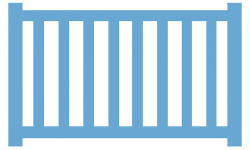Installing a Vinyl Fence is a fantastic way to enhance the privacy and aesthetic appeal of your home. At Utah Fencing Company, we understand the importance of a beautifully installed fence and the role it plays in making your house feel like a secure, welcoming home. This step-by-step guide aims to equip homeowners with the knowledge to expertly install a Vinyl Fence. Whether you’re a DIY enthusiast or considering professional help, this article is designed to guide you through the process, ensuring a smooth and successful Installation.
Planning Your Vinyl Fence Installation
Before you dig the first hole or purchase any materials, effective planning is crucial. Start by determining the purpose of your Vinyl fence. Is it for privacy, pet containment, or aesthetic reasons? Knowing the purpose will help you decide on the fence design and height. Next, check with your local building department for any specific regulations or permits required. It’s also wise to discuss your plans with neighbors if the fence will be bordering their property.
Finally, have all underground utilities marked to avoid any accidents during installation. This foresight can save you from unnecessary headaches and ensure a smooth installation process.
Choosing the Right Vinyl Fence
With your plan in place, selecting the right vinyl fence is the next step. Vinyl fences come in a variety of styles including privacy, picket, and shadowbox. Each style serves a different purpose and offers varying levels of privacy and aesthetic appeal. Consider also the color and texture options available that will complement your home’s exterior.
It’s important to invest in high-quality vinyl fencing materials. Not all vinyl is created equal, and opting for premium quality can ensure your fence withstands the test of time and weather conditions. At Utah Fencing Company, we offer a wide selection to meet your specific needs and preferences.
Gathering Your Tools and Materials
Now that you’ve selected your fence, gathering the necessary tools and materials is your next move. Essential tools for vinyl fence installation include post hole diggers, a level, a measuring tape, a rubber mallet, and a saw for cutting the vinyl sections to size. You’ll also need specific hardware that typically comes with your fence kit, like post caps and brackets.
Don’t forget safety gear such as gloves and eye protection. Being prepared with the right tools and materials will make the installation process smoother and more efficient.
Marking and Preparing the Area
With tools and materials ready, it’s time to mark and prepare the installation area. Begin by carefully marking the boundary lines of where the fence will be installed. Using string lines or spray paint can help maintain straight lines and accurate spacing between posts. It’s important to measure carefully, as accurate spacing ensures the stability and appearance of your vinyl fence.
Next, clear the fence line of any obstacles such as rocks, roots, and debris. Ensuring the area is clear facilitates easier digging and a more efficient installation process.
Digging Holes and Setting Fence Posts
One of the most critical steps in installing your vinyl fence is digging the holes for the fence posts. Each hole should be roughly 10 inches in diameter and deep enough to support about one-third of the post length for stability. Using a post hole digger or an auger can make this process easier.
After digging the holes, place the first post and use a level to ensure it’s perfectly vertical. Pour Concrete around the post, then check the level again before the concrete sets. Repeat this process for each post, making sure to maintain proper alignment and spacing based on your initial plans.
Important Considerations for Vinyl Fence Installation
- Check Local Regulations – Ensure you understand and comply with local building codes and homeowner association guidelines to avoid fines or having to redo the work.
- Slope Considerations – For properties with slopes, plan the layout to ensure the fence remains even and aesthetically pleasing across changes in elevation.
- Expanding and Contracting – Vinyl materials can expand and contract with temperature changes. Leave appropriate gaps during installation to accommodate this.
- Maintenance and Care – Though vinyl fencing is low maintenance, it’s beneficial to know the recommended cleaning methods to preserve your fence’s appearance over time.
- Professional Assistance – When in doubt, consult with or hire a professional fencing company to ensure the job is done right, saving time and potential hassle.
Attaching Fence Panels
With the posts in place and properly set, the next step is to attach the vinyl fence panels. Slide the panels into the brackets located on the posts and secure them according to the manufacturer’s instructions. Ensuring panels are level and firmly attached is crucial for the fence’s durability and overall look.
It’s often helpful to have an extra pair of hands during this step to hold the panels steady while attaching them. This teamwork can significantly streamline the installation process.
Installing Gates and Additional Features
For many homeowners, installing a gate is a crucial part of the fence installation process. Measure the gate opening carefully, and ensure the posts are securely set to support the gate’s weight. Attach the gate hardware and gate itself, double-checking for level and swing clearance.
If your vinyl fence design includes decorative elements such as post caps, now is the time to add them. These features not only enhance the fence’s appearance but can also serve to protect post tops from weather elements.
Final Inspection and Maintenance Tips
After installation, conduct a thorough inspection of your vinyl fence. Check for stability, proper gate function, and any adjustments needed in the panels or posts. Ensuring everything is correctly installed and operational at this stage can save future maintenance and adjustments.
Maintaining your vinyl fence is relatively simple. Regular cleaning with soap and water, along with immediate removal of any mildew or stains, can keep your fence looking new for years. Additionally, periodically checking for loose or damaged components allows for timely repairs and maintains the fence’s integrity.
Conclusion
At Utah Fencing Company, we take pride in empowering homeowners with the knowledge and resources to beautify their homes with durable, aesthetically pleasing vinyl fences. Whether you choose to tackle installation on your own or prefer professional help, we’re here to assist. For expert advice or assistance, feel free to reach out to us by phone at 801-905-8153 or Request a Free Quote. Our team is eager to help you enhance your home’s appearance and privacy with a high-quality vinyl fence.




